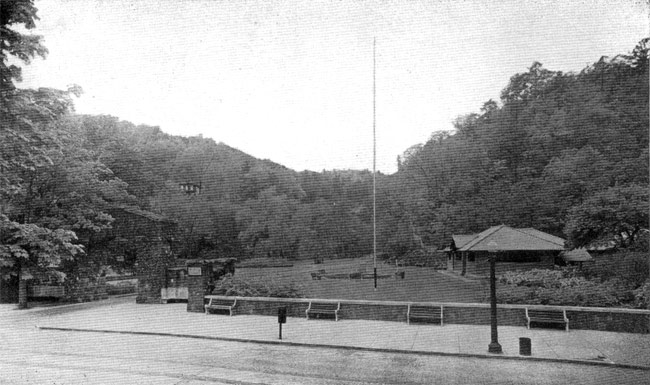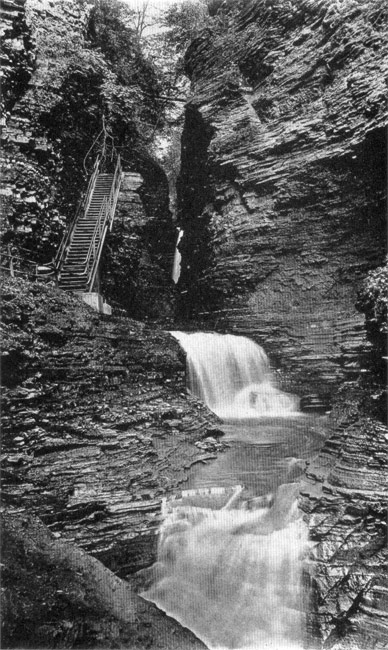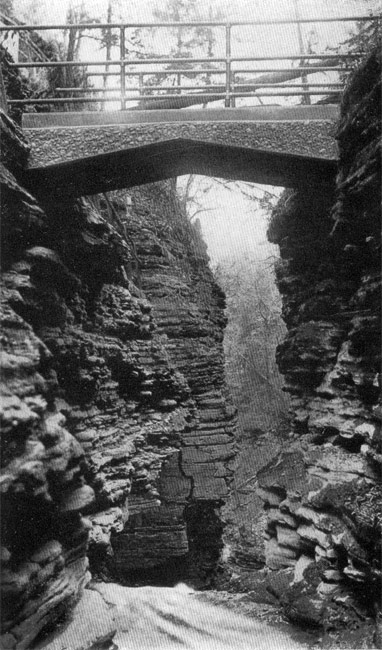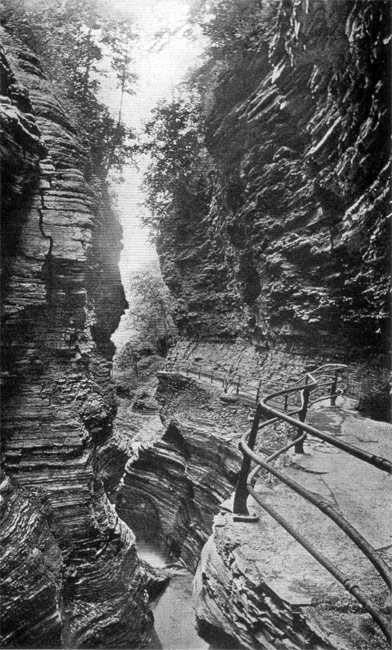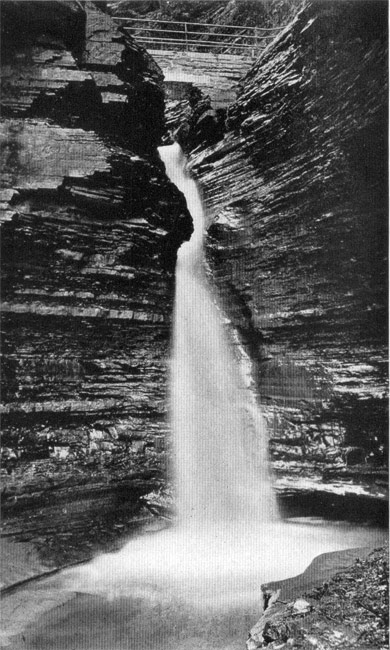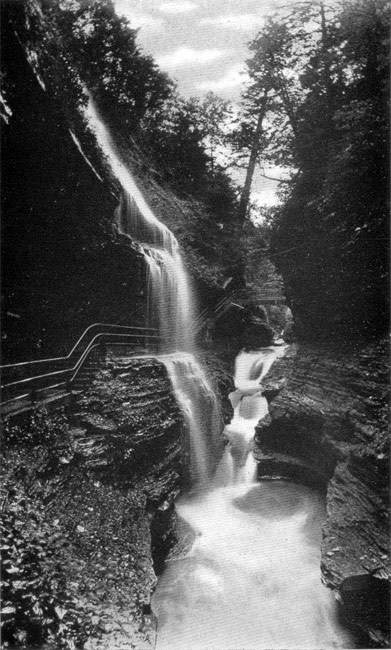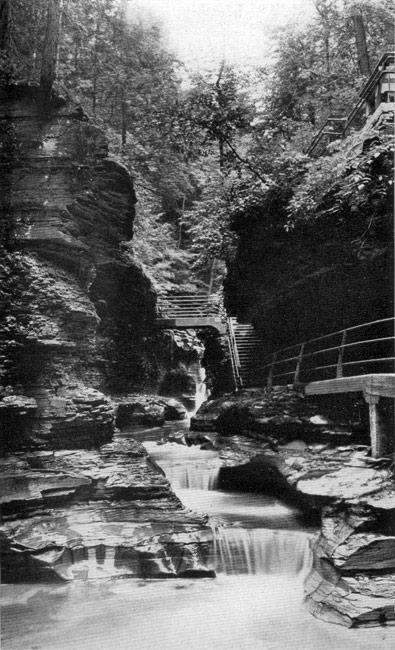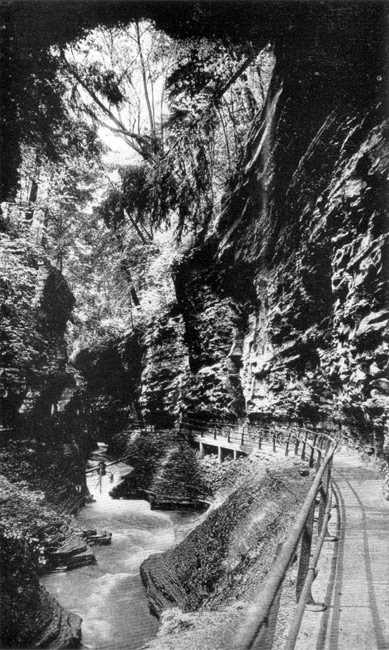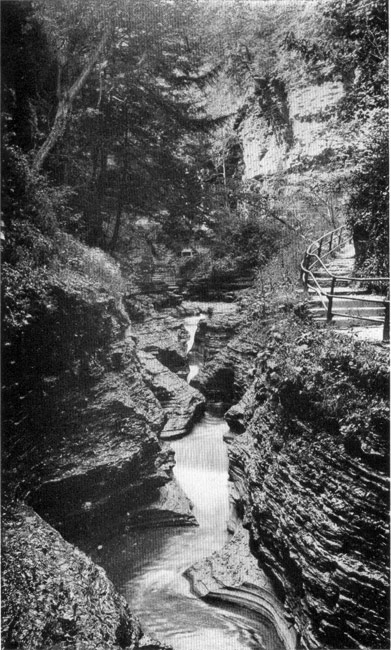The following is a a word-for-word reprint of the text, and in some cases, images, of a printed brochure from 1903. Any typos or inaccuracies have been left intact, but the document has been re-flowed to fit the webpage. This book is now a part of the public domain. A lot has changed since then, which is why we are publishing this content. It is for educational purposes only. If you want more recent guides and descriptions, see our Watkins Glen State Park page.
The Glen Springs: Watkins Glen, N.Y.
THE GLEN SPRINGS
WATKINS GLEN, N.Y.
THE GLEN SPRINGS
WATKINS GLEN
NEW YORK
WM. E. LEFFINGWELL
PRESIDENT AND GENERAL MANAGER
Persons suffering from Tuberculosis, or any other contagious or offensive disease, Epileptics and persons afflicted with any form or insanity, are not received at The Glen Springs.
MIII
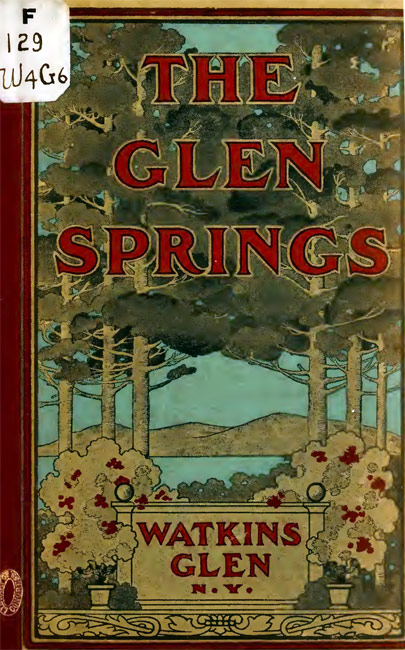
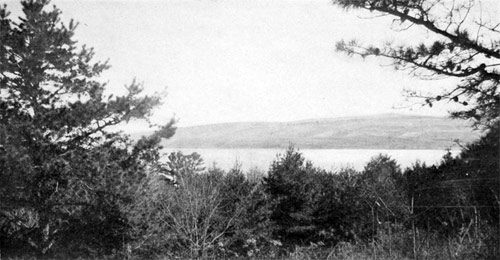
IN DECIDING upon this location the management feel that they have chosen wisely. This region has long been noted for the purity of its water, its freedom from malaria, and its dry and equable climate. Seneca Lake is one of the most remarkable bodies of water known. It is fed by deep springs, and has only frozen over twice in the last century. For beauty of scenery and richness of coloring it has no superior ; its shores are grand and picturesque, the sides thickly wooded in places, in others covered with fruit orchards and vine- yards. This vast body of water, nearly forty miles long and from two to four miles wide, exerts an unquestioned influence in purifying and invigorating the air, tempering it in winter, and cooling and refreshing it in summer. A remarkable feature of this region is the great number of its sunny days during the fall, winter, and spring. Persons familiar with the cloudy, grey skies in localities nearer the Great Lakes will be agreeably surprised at the great amount of sunshine which prevails in this section. The record for 36s days has shown that there were only fifty-five cloudy days. The Glen Springs stands upon a broad plateau 300 feet above the lake, whose winding course it overlooks for nearly thirty miles. It is surrounded by pine forests and backed by an amphitheatre of hills rising in regular terraces to nearly 1,500 feet.
At the foot of the hill, less than a quarter of a mile away, lies the village of Watkins, with its churches, shady streets and beautiful homes, while the entrance to the famous Watkins Glen and the landing of the Seneca Lake steamers are both within seven minutes’ easy walking distance.
The Glen Springs Park comprises sixty acres of woodland and lawn about equally divided, and one can wander for miles over well-built walks, obtaining from almost every point grand and beautiful vistas of lawn, lake, forest, and glen. Within the park are bowling alleys, tennis courts, croquet grounds, and golf links. Pleasant drives abound in every direction, while those who prefer the water will find every convenience for boating at the steamer landing. Good fishing is found in Seneca Lake ; and within easy driving distance, over good roads, one can reach Keuka, Lamoka, Cayuta, and Little lakes, all famous fishing resorts. The open waters of Seneca Lake afford good duck shooting all winter, and an abundance of quail, partridge, and squirrel offer excellent shooting during the season.
The main building, heated by steam and lighted by electricity and gas, consists of four stories and a basement, constructed in the most substantial manner of brick and stone, with floors deadened with cement. It faces the east, thus commanding the genial morning sun, and the grateful afternoon shade, while its situation, upon a broad plateau, renders all rooms, rear as well as front, equally healthful. A safety hydraulic elevator connects every floor, from the basement to the roof, and electric bells communicate from every room with the main office. A new addition to the main building was completed in 1903. The rooms are so arranged that suites of from one room and bath to nine rooms and as many baths as may be required are at the disposal of the guests.
On the first floor of the main building are the parlors, the dining room, the library, the reading rooms, card rooms, smoking rooms, sun parlor, writing rooms, and offices, and in the basement of the new addition is a large billiard and pool room.
The Annex is heated by steam and lighted by gas and electricity. The rooms are arranged en suite and pro-vided with all modern conveniences. Private bath rooms are attached to a number of suites.
The main building and annex are connected by a wide corridor, or solarium, enclosed in glass and heated in cold weather by steam, so that both buildings are practically under one roof. This corridor, or solarium, affords ample space for exercise in stormy weather, and is a very unique and attractive feature of the place. It commands at every point magnificent views of both lake and forest.
MINERAL SPRINGS. It is a well-known fact to the medical profession that, while there are in this country mineral springs of equal value as remedial agents to those in Belgium, France, and Germany, physicians have been obliged to send their patients abroad, because, with few exceptions, our springs are not supplied, as they are in those countries, with institutions where a thorough and scientific use is made of their mineral properties.
The management of The Glen Springs believe they have met a great need in establishing an institution in which the most advanced medical treatment is employed, and at the same time the valuable mineral waters known as ” The Glen Springs ” can be enjoyed to their fullest extent.
The waters which have given reputation and name to this beautiful location are equal to any of the kind found in Europe. There are five large mineral springs located upon the grounds, which are used for drinking and baths.
THE NEPTUNE AND DEER LICK SPRINGS.
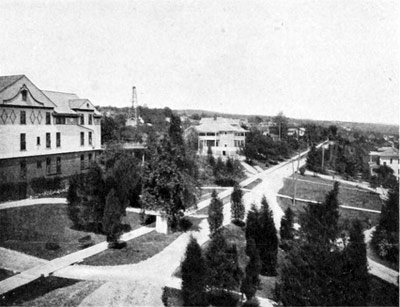
Special attention is directed to the Neptune and Deer Lick Springs which give distinct character to The Glen Springs as a mineral spring resort.
The waters of the Neptune Spring belong to the class of muriated salines described as iodo-bromo-muriated brines, which are used for bathing cures at a number of the popular European resorts.
The waters of the Deer Lick Spring are of the class described as iodo-bromo-muriated salines and used for drinking cures at popular European spas.
A comparative analysis will show the waters of the Neptune and Deer Lick Springs to be the equal of the best-known European Springs of the same class, and in some cases to be greatly superior.
Saline baths conjoined with the drinking cures with iodin waters constitute a very valuable treatment for many diseased conditions.
The cures administered at Kreuznach and at Hall in Upper Austria are after this method. The same combination of mineral water cure may be had at The Glen Springs, because or the Neptune and Deer Lick Springs.

This circular will contain only the analysis and a brief description of the mineral waters of The Glen Springs. For a description of the physiological and therapeutic effects of the waters and a statement of the diseased conditions for which they are beneficial, the reader is referred to the pamphlets, ” The Glen Springs, A Natural, Distinct, Health Resort,” and ” The Nauheim Bath or Schott Treatment.”
NEPTUNE SPRING.
ANALYSIS.
Specific gravity 1,133 Salinometer 67°—.
One U. S. gallon of brine yields 1.62 lbs. of salt. One gallon of this brine contains :
Chloride of Calcium, 3,499.08 Grains.
Chloride of Magnesium, 635.67 ”
Chloride of Sodium, 6,368.33 ”
Iodide of Sodium Trace.
Bromide of Sodium, ”
Iron and Alumina, 10,503.08
grains per gallon.
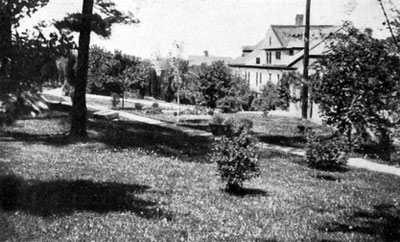
This brine differs from all I have ever analyzed, and also, I think, from nearly all whose analyses have been reported — namely, the total absence of sulphite of calcium (gypsum), which is almost invariably present in a greater or less proportion in brine everywhere. No other sulphates are present in this brine. The very large percentage of lime (calcium) in the form of chloride is equally exceptional in my experience.
S. A. LATTIMORE,
Professor of Chemistry, University of Rochester.
This is a brine spring originating about seven-teen hundred feet below the surface of the earth and belongs to the same class as the famous brine springs of Nauheim, Kreuznach, Homburg, Wiesbaden, Kissingen, Rehme, Jaxtfelt, Harrowgate, and Cheltenham.
The water of this spring is of great value, especially for bathing. It belongs to the class of Iodo-Bromated Brines. It is free from sulphate of lime, and is very rich in chloride of calcium. No other spring in this country contains more than one-fourth as much of this valuable medicinal salt. The following is an extract from a table showing comparative potency of representative American and European springs :
MURIATED-SALINE.
AMERICAN.
Glen Springs, N. Y. (Neptune), 10503.08 Grains.
(Used for Schott-Nauheim treatment.)
Geuda Springs, Kansas, 1314.78 ”
Eureka Springs, California, 1800.27 ”
Sweet Springs, Mo. (Akesion Spr. ), 1061.94 ”
Lodi Artesian Well, Indiana, 672.45 ”
Upper Blue Lick, Kentucky, 660.14 ”
EUROPEAN.
Springs of Nauheim, Germany, 2148. 07 Grains.
(Friedrich-Wilhelm’s Quelle.)
Kreuznach ( Oranien-Quelle) 1084. 32 ”
Homburg, Germany (Eliz. Brunnen), 870.96 ”
Harrowgate, England, 864.43 ”
Cheltenham, England, 644.00 ”
Wiesbaden, Ger. (Koch. Brunnen), 507. 70 ”
grains per gallon.

The strongest waters of this class on the globe are found in the United States. (See Note.)
By carefully comparing the analysis of the Neptune Brine with that of Nauheim it will be seen that after charging t h e Neptune Brine with carbonic acid gas and diluting the stronger brine of this spring with hot water to produce the desired temperature, the patient can be immersed in a bath identical with that used at Bad-Nauheim.
THE NAUHEIM TREATMENT.
It is evident that because of the Neptune Brine, we are able to administer the Nauheim Treatment in a manner second only to that of Nauheim. The climate and surroundings are also such that we can properly call THE GLEN SPRINGS the Nauheim of America.
For a full description of the Nauheim Treatment and the consideration of its curative value, please read the pamphlet devoted entirely to the subject.
NOTE.- “A Word About American Mineral Waters and Mineral Springs Resorts,” by James K. Crook, M. D., Medical Record, New York, June 28, 1902. Neptune Brine is also used for balneotherpy in the Full Brine Baths, Neptune Salt Rubs, Fomentations, Compresses, Packs, Sprays, Douches, Electro-chemical and Vapor Baths.
DEER LICK SPRING.
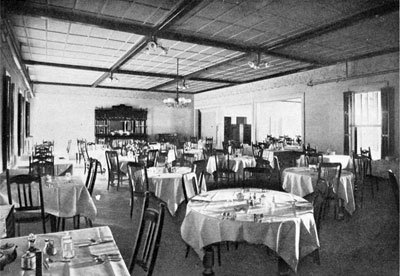
ANALYSIS.
One U. S. gallon of 231 cubic inches contains :
Chloride of Sodium, 114.7561 Grains
Chloride of Potassium, 0.2309 ”
Bromide of Sodium, 0.5962 ”
Iodide of Sodium, 0.0362 ”
Sulphate of Potassa, Traces
Bicarbonate of Lithia, ”
Bicarbonate of Ammonia, 1.0841 Grains
Bicarbonate of Iron, 1.7257 ”
Bicarbonate of Lime, 41.7667 ”
Bicarbonate of Magnesia, 19.2804 ”
Alumina, 0.3382 ”
Phosphate of Soda, Traces
Silica, 0.6415 ”
Total solids, 180.4560 Grains
CHAS. F. CHANDLER, PH. D.,
School of Mines, Columbia College, New York.

The water of Deer Lick Spring is clear and sparkling, without odor, and with a slightly astringent, mildly saline taste. It belongs to the Ferrated-Iodo-Brom-ated-Muriated Springs The water is rich in that valuable constituent, carbonic acid gas, which has been appropriately called “The Spirit of Springs.” The spring occupies the site of an ancient deer lick. The Indians, recognizing its valuable qualities, had erected a log-curbing around it, remains of which were found during subsequent excavations. Deer Lick resembles, in many respects, the waters of Kreuznach, Hall, Duerkheim, and Kraukenheit. According to Professor Chandler’s analysis, it ranks higher for drinking purposes than any of these famous springs. Waters richer in salines than the blood must be diluted before using. This is the objection to most of the foreign Iodo-Bromated Springs, while Deer Lick is sufficiently diluted for drinking as it emerges from the earth.
[Incomplete text]…the character of their solid constituents, while there is a difference in the contained amounts.
They are, however, comparable with the famous springs of their classes and are excel-lent waters. With the slight disadvantage of requiring a larger liquid dosage they possess therapeutic efficiency not exceeded by the stronger waters.

VULCAN SPRING.One U. S. gallon of 231 cubic inches contains :

ANALYSIS.
Calcium Carbonate, 29.80 Grains.
Magnesium Carbonate, 11.37 ”
Iron Carbonate, 1.87 ”
Sodium Chloride, 149.06 ”
Alumina, Trace.
Silica, ”
Total Mineral Constituents, 192.10 Grains.
This water also contains much carbonic acid gas.
S. A. LATTIMORE,
Professor of Chemistry, University of Rochester.
This is also a clear, sparkling water, and issues from the rock at a depth of 100 feet. It belongs to the same class of mineral waters as those of the Kissingen Spa, the iodic-muriated salines.
SALUBRIA SPRING.
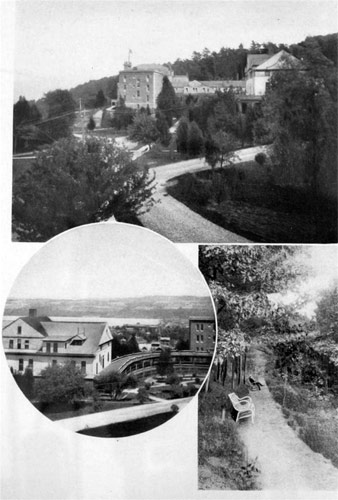
ANALYSIS.
One U. S. gallon of 231 cubic inches contains :
Sodium Chloride, 196.28 Grains.
Calcium Carbonate, 19.68 ”
Magnesium Carbonate, 0.05 ”
Silica, Trace.
Total, 216.01 Grains.
S. A. LATTIMORE,
Professor of Chemistry, University of Rochester.
This spring issues from the rock at a depth of 250 feet and belongs to the class of Muriated Alkaline Springs. In composition, it resembles the waters of Vichy, Tachingen, and Bilin, but is more closely related to the waters of Kissingen, Homburg, Wiesbaden, Baden-Baden, Mondorf, Constatt, and Sodan. It also resembles the waters of Saratoga. The taste of the water is quite similar to Kissingen.
SENEGA SPRING.
ANALYSIS.
One C. S. gallon of 231 cubic inches contains:
Calcium Carbonate, 9.90 Grains.
Calcium Sulphate, 0.47 ”
Magnesium Carbonate, 2.10 ”
Sodium Chloride 0.12 ”
Silica, 0.07 ”
Oxide of Iron, Trace.
Total Solids, 12.66 Grains.
This water is entirely free from organic matter.
S. A. LATTIMORE,
Professor of Chemistry, University of Rochester.
This spring is situated zoo feet higher than the buildings. It flows nearly 100,000 gallons per day of deliciously cool, pure water, which is conducted into two large reservoirs, from which it is distributed through mains to all buildings for general domestic purposes. The reader is referred to the Prescription Booklet and the Pamphlets, “The Nauheim Bath or Schott Treatment,” and ” The Glen Springs, A Natural, Distinct, Health Resort.”
THE BATH-HOUSE.
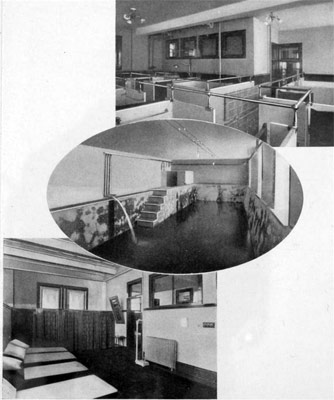
The bath-house is a new two-story building, which is devoted entirely to the bath departments for women and men. The building is of brick, with tile floors and marble wainscoting and partitions. It is heated and ventilated in the most approved manner. The management has planned to make this building, with all the appliances, complete, convenient, and elegant.
The bath-house is directly connected with the main building. Entrance is gained by means of the elevator, with-out the necessity of using stairs. The second floor contains the bath, dressing and resting rooms for the use of the women ; the first floor, similarly arranged, is for the use of the men.
By means of our natural mineral springs, we are able to give all the various forms of Iron and Salt Baths which have obtained such wide popularity in the different Continental health resorts.
The Nauheim Baths (Carbonated Neptune Brine), Electro-Brine Baths, and Neptune Brine Baths are the special features of The Glen Springs. The Glen Springs is also thoroughly equipped with all the latest and most approved therapeutic appliances for hydrotherapy in all forms, including Turkish and Russian Baths (in connection with which department there is a swimming pool nearly forty feet long), Roman, Electro-Thermal and Electro Chemical Baths, Vacuum Treatment, Swedish Movements, Electric Light Baths, and Hot Air Treatment (Betz Apparatus), Massage, Electricity in every form, including Faradic, Galvanic, Static, Sinusoidal, and Electric Massage.
All the treatments are given by skilled attendants after the manner prescribed by the resident physician in charge of the patient. (See the prescription booklet.)

THE TREATMENT.
The treatment consists in a combination of baths and the administration of the mineral waters, together with the other established scientific methods suited to the individual case.
The mineral waters possess valuable curative properties which have been established by long and varied experience.
The physicians of the place have reason to expect cures in gout, rheumatism, sciatica, neuritis, neuralgia, chlorosis, nervous prostration, dyspepsia in various forms, gastro intestinal catarrh, and constipation.
Marked benefit will be received by patients with chronic diseases of the liver and kidneys, old joint injuries, and locomotor ataxia.
The disappearance of glycosuria in patients with diabetes proves the value of the waters in that disease.
The Nauheim Treatment has been found curative in functional diseases of the heart and to materially relieve heart invalids of all classes. Patients suffering with angina pectoris have derived great and lasting relief. This treatment is also of value in other diseases than those of the heart.
RESIDENT MEDICAL STAFF.
JAMES K. KING, M. D., Chairman,College of Physicians and Surgeons, New York.
JOHN L. MEEKER, M. D.,
Baltimore Medical College, Baltimore.
RICHARD N. W. K. HORNER, M. D.,
University of City of New York.
CAROLINE F. J. RICKARDS, M. D.,
Woman’, Medical College, Philadelphia.
Please address all communications to ” The Glen Springs.”
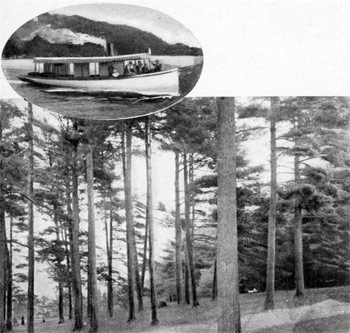
HAY FEVER.
The New Fork Medical Record of June 20, 1891, published a map showing “the extent of hay fever ” in the Eastern and Central States. The Glen Springs is situated in nearly the center of a belt in which hay fever does not prevail, according to this map. The freedom from this disease experienced by a number of long-established cases that have spent the summers with us, and the absence of la grippe during the past winters, confirm the correctness of the author’s map so far as the region about the head of Seneca Lake is concerned.
The map on page 47 is made up from a topographic survey of Seneca Lake, made by Prof. E. A. Fuertes of Cornell University, Director of the Meteorological Bureau of the State of New York, and a theometric survey by Rev. Dwight W. Smith. There are only two other lakes in the world (one in Scot-land and one in South America) possessing similar characteristics. Seneca Lake is shown by these surveys to be the coldest lake in North America, and one of the deepest. It maintains, at a depth of 200 feet, a uniform temperature of 7° above freezing throughout the year. The temperature of the water is so low that evaporation is very slight, rendering the air unusually free from humidity, which accounts for the absence of fogs, the clear skies, and the coolness and freshness of the surrounding atmosphere in summer.
The great depth of the lake, and the chief water supply coming from springs, account for its not freezing, and for the mild and equable climate, during the winter months.
These features all tend to make The Glen Springs the most desirable and beneficial winter health resort in the North.
CLIMBING EXERCISES.
The Glen Springs is partially surrounded by pine woods, and backed by an amphitheatre of hills, rising in regular terraces to about 1,500 feet. The suitability of such a location for the systematic climbing exercises, as recommended by Stokes and Oertel for patients suffering from disease of the heart, is apparent. (See the map of The Glen Springs Park. )
The management aim to furnish the cuisine, conveniences, and service of a family hotel of the highest class.
An orchestra plays in the parlors every morning and evening. Sacred concert every Sunday evening.
There is a first-class livery connected with the house. Excellent accommodations furnished for those who prefer to bring their own horses and carriages.

PRICES.
These vary according to the size, location, and furnishings of rooms, from $35 to $50 per week. Where two per-sons occupy the same room the price for both will vary between $56 and 70 per week. Rooms with private bath-room, extra. Special prices made, on application, for children and servants.
The above prices include medical attention and treatment. Special treatment of the eye, ear, nose, or throat, and treatments in rooms, are extra. Night attendance, medicines, and meals in room are also extra.
ROUTES.
From New York, take the Erie, or Delaware & Lackawanna R. R., to Elmira, changing there to the Northern Central for Watkins ; or, the New York Central, changing at Lyons to the Pennsylvania Division.
From Albany and New England points, take the Chicago sleeper, via the Delaware & Hudson, for Elmira, changing there to the Northern Central for Watkins ; or, the Boston & Albany and New York Central, changing at Lyons to the Pennsylvania Division.
From Philadelphia, Baltimore, Washington, and the South, take the Northern Central direct to Watkins.
From Cincinnati, St. Louis, and the Southwest, take the Southwestern Limited, via the ” Big Four Route,” direct to Rochester, changing in Union Depot to Northern Central for Watkins.
From Chicago, the West, and North-west, take the Lake Shore or Michigan Central to Rochester, changing there as above. The Northern Central R. R. (a division of the Pennsylvania System) runs from Rochester to Baltimore, Philadelphia, and Washington, connecting at Rochester, in Union Depot with the New York Central, West Shore, Michigan Central, Lake Shore, and ” Big Four Route “; at Canandaigua, with the Auburn Branch of the New York Central; at Elmira, with the Erie and Delaware & Lackawanna ; at Harrisburg, with the main line of the Pennsylvania R. R., and at Washington with routes for the South.
The New York Central (Penn. Division) Railroad has a depot about a mile and a half from Watkins. This road connects at Lyons with the main line of the New York Central ; at Geneva with the Auburn Branch of the New York Central, and at Corning with the Erie and Delaware & Lackawanna. A trans-fer ‘bus meets all New York Central trains. The Lehigh Valley 12. R. has a depot at Burdette, about two miles from Watkins. Passengers coming by the Lehigh Valley or New York Central are advised to telegraph for a carriage to meet them.
The Glens Springs coach meets all day trains on the Northern Central R. R.
For further particulars address
WM. E. LEFFINGWELL,
President and General Manager,
WATKINS, N. Y.
WE would respectfully refer to the persons whose names are hereto appended, and who have either been guests or have had members of their families at The Glen Springs. None of the persons have been consulted as to the use of their names, but any of them, if approached at proper times, would doubtless give any information they may possess about The Springs.
NEW YORK CITY.
Mr. Conrad Jordan, Mr. and Mrs. S. H. Kissam, Mr. and Mrs. John I). Rockefeller, Mr. and Mrs. John A. Hardenburgh, Mrs. S. S. Cox, Mr. and Mrs. 1. E. Holbrook, NB% and Mrs. T. D. Jordan, Mr. and Mrs. Frederick Cromwell, Mr. and Mrs. Edward E. Poor, Mrs. Geo. De Forest Lord, Mrs. NV. H. Webb, M, and Mrs. Horace Maxwell, Mr. and Mrs. F. G. Ely, Gen. Emmons Clark. Mr. and Mrs. John Townshend, Mr. and Mrs. Geo. H. Hughes, Hon. and Mrs. R. C. Shannon, Mr. A. R. Macdonough, Gen. and Mrs F. U. Starring, Mr. Geo. R. Reed, M, and Mrs. Wm. McMurtrie, Miss G. B. Ballard, Miss E. Doheny, Rev. Dr. and Mrs. George C. Houghton, Mr. and Mrs. C. Armstrong, Mr. and Mrs. S. P. Avery. Mr. Anson Maltby, Mr. and Mrs. J. F. McClore, Mr. and Mrs. Richard Butler, Hon. and Mrs. E. B. Hinsdale, Airs. John H. Hinton and Miss Hinton, Mr. H. L. Horton, Mr. and Mrs. Winthrop Cowdin, Mr. and Mrs Geo. C. Rand, Mr. and Mrs. H. Trevor, Mr. and Mrs. Francis C. Moore, Mr. and Mrs. W. B. Coughtry, Mrs. Theodore M. Barnes, Mr. A. S. Runyon, Mrs. C. NV. Armour, Mr. and Mrs. Herbert Jerome Davis, Dr. A. L. Ranney, Mr. and Mrs. Washington L. Jaques, Gen. and Mrs. C. A. Whittier, Mrs. Edward H. Perkins, Jr., Mrs. Frederick Neilson, Mrs. Arthur Kemp, Mr. D. Le Roy Dresser Hon. S. H. Lyman, Mr. Frederick Gebhard, Mr. and Mrs. Chas. B. Hobbs, Hon. and Mrs. George Hoadley, Mrs. J. T. Martin, M, L. V. F. Randolph, Mr. and Mrs. H. I. Judson, Mr. and Mrs. Rush Taggart, Mr. John G. Floyd, Mr. Charles F. McKim, Mr. and Mrs. Henry Stanton.
NEW YORK.
BROOKLYN.—Mrs. Henry Sanger, Mr. and Mrs. T. T. Barr, Mr. Wm. H. Male, Mr. Wm. B. Boreum, Mr. and Mrs. E. E. Jackson Jr., Mr. and Mrs. John L. Heaton, Mr. and Mrs. Webster C. Estes, Mr. and Mrs. H. O. Wood, Dr. and Mrs. D. H. Cochran, Mr. D. W. Mc-Williams, Mrs. Edmond Terry, Mr. and Airs. W. N. Hallock. Mr. F. R. Kellogg, Mr. and Mrs. W. H. Baldwin, Jr., Hon. Alexander E. Orr, Mr. and Airs. A. W. Bailey, Mr. and Mrs. C. S. Lord, Mt.. and Mrs. Wm, Spies. BUFFALO.— Air. and Mrs, P. B. McNaughton, Mr. and Mrs. George H. Lewis, NI, and Mrs. Dudley Irwin, Mr. and Mrs. John ‘I’ Stewart, Mr. and Mrs. John A. Mann, Mr. and Mrs. James M. Satterfield.

Photos in the Guide
